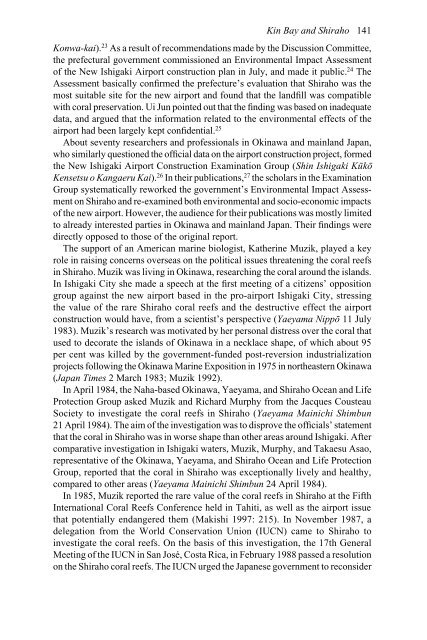Myth, Protest and Struggle in Okinawa
Myth, Protest and Struggle in Okinawa
Myth, Protest and Struggle in Okinawa
You also want an ePaper? Increase the reach of your titles
YUMPU automatically turns print PDFs into web optimized ePapers that Google loves.
K<strong>in</strong> Bay <strong>and</strong> Shiraho 141<br />
Konwa-kai). 23 As a result of recommendations made by the Discussion Committee,<br />
the prefectural government commissioned an Environmental Impact Assessment<br />
of the New Ishigaki Airport construction plan <strong>in</strong> July, <strong>and</strong> made it public. 24 The<br />
Assessment basically confirmed the prefecture’s evaluation that Shiraho was the<br />
most suitable site for the new airport <strong>and</strong> found that the l<strong>and</strong>fill was compatible<br />
with coral preservation. Ui Jun po<strong>in</strong>ted out that the f<strong>in</strong>d<strong>in</strong>g was based on <strong>in</strong>adequate<br />
data, <strong>and</strong> argued that the <strong>in</strong>formation related to the environmental effects of the<br />
airport had been largely kept confidential. 25<br />
About seventy researchers <strong>and</strong> professionals <strong>in</strong> Ok<strong>in</strong>awa <strong>and</strong> ma<strong>in</strong>l<strong>and</strong> Japan,<br />
who similarly questioned the official data on the airport construction project, formed<br />
the New Ishigaki Airport Construction Exam<strong>in</strong>ation Group (Sh<strong>in</strong> Ishigaki Kūkō<br />
Kensetsu o Kangaeru Kai). 26 In their publications, 27 the scholars <strong>in</strong> the Exam<strong>in</strong>ation<br />
Group systematically reworked the government’s Environmental Impact Assessment<br />
on Shiraho <strong>and</strong> re-exam<strong>in</strong>ed both environmental <strong>and</strong> socio-economic impacts<br />
of the new airport. However, the audience for their publications was mostly limited<br />
to already <strong>in</strong>terested parties <strong>in</strong> Ok<strong>in</strong>awa <strong>and</strong> ma<strong>in</strong>l<strong>and</strong> Japan. Their f<strong>in</strong>d<strong>in</strong>gs were<br />
directly opposed to those of the orig<strong>in</strong>al report.<br />
The support of an American mar<strong>in</strong>e biologist, Kather<strong>in</strong>e Muzik, played a key<br />
role <strong>in</strong> rais<strong>in</strong>g concerns overseas on the political issues threaten<strong>in</strong>g the coral reefs<br />
<strong>in</strong> Shiraho. Muzik was liv<strong>in</strong>g <strong>in</strong> Ok<strong>in</strong>awa, research<strong>in</strong>g the coral around the isl<strong>and</strong>s.<br />
In Ishigaki City she made a speech at the first meet<strong>in</strong>g of a citizens’ opposition<br />
group aga<strong>in</strong>st the new airport based <strong>in</strong> the pro-airport Ishigaki City, stress<strong>in</strong>g<br />
the value of the rare Shiraho coral reefs <strong>and</strong> the destructive effect the airport<br />
construction would have, from a scientist’s perspective (Yaeyama Nippō 11 July<br />
1983). Muzik’s research was motivated by her personal distress over the coral that<br />
used to decorate the isl<strong>and</strong>s of Ok<strong>in</strong>awa <strong>in</strong> a necklace shape, of which about 95<br />
per cent was killed by the government-funded post-reversion <strong>in</strong>dustrialization<br />
projects follow<strong>in</strong>g the Ok<strong>in</strong>awa Mar<strong>in</strong>e Exposition <strong>in</strong> 1975 <strong>in</strong> northeastern Ok<strong>in</strong>awa<br />
(Japan Times 2 March 1983; Muzik 1992).<br />
In April 1984, the Naha-based Ok<strong>in</strong>awa, Yaeyama, <strong>and</strong> Shiraho Ocean <strong>and</strong> Life<br />
Protection Group asked Muzik <strong>and</strong> Richard Murphy from the Jacques Cousteau<br />
Society to <strong>in</strong>vestigate the coral reefs <strong>in</strong> Shiraho (Yaeyama Ma<strong>in</strong>ichi Shimbun<br />
21 April 1984). The aim of the <strong>in</strong>vestigation was to disprove the officials’ statement<br />
that the coral <strong>in</strong> Shiraho was <strong>in</strong> worse shape than other areas around Ishigaki. After<br />
comparative <strong>in</strong>vestigation <strong>in</strong> Ishigaki waters, Muzik, Murphy, <strong>and</strong> Takaesu Asao,<br />
representative of the Ok<strong>in</strong>awa, Yaeyama, <strong>and</strong> Shiraho Ocean <strong>and</strong> Life Protection<br />
Group, reported that the coral <strong>in</strong> Shiraho was exceptionally lively <strong>and</strong> healthy,<br />
compared to other areas (Yaeyama Ma<strong>in</strong>ichi Shimbun 24 April 1984).<br />
In 1985, Muzik reported the rare value of the coral reefs <strong>in</strong> Shiraho at the Fifth<br />
International Coral Reefs Conference held <strong>in</strong> Tahiti, as well as the airport issue<br />
that potentially endangered them (Makishi 1997: 215). In November 1987, a<br />
delegation from the World Conservation Union (IUCN) came to Shiraho to<br />
<strong>in</strong>vestigate the coral reefs. On the basis of this <strong>in</strong>vestigation, the 17th General<br />
Meet<strong>in</strong>g of the IUCN <strong>in</strong> San José, Costa Rica, <strong>in</strong> February 1988 passed a resolution<br />
on the Shiraho coral reefs. The IUCN urged the Japanese government to reconsider
















